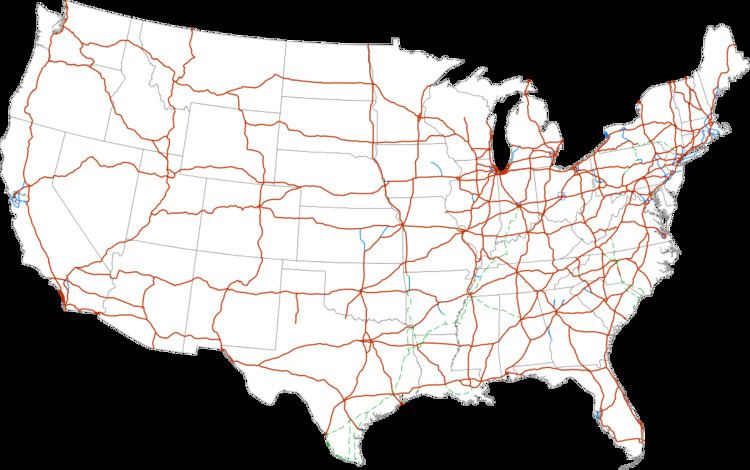Formed: June 29, 1956 | Interstates: Interstate X (I-X) | |
 | ||
The auxiliary Interstate Highways (also called three-digit Interstate Highways) are a supplemental subset of the freeways within the Interstate Highway System of the United States. Similar to the mainline Interstate Highways, these highways also meet all Interstate Highway Standards (with rare exceptions), they receive the same percentage of federal funding (90%), and they comply with other federal standards.
Contents
Auxiliary routes are generally classified as spur routes (which connect to the parent route at one end), bypasses (which connect to the parent route at both ends), or beltways, which form a complete circle intersecting the parent route at two locations. There are some routes which connect to the parent route at one end, but connect to another route at the other end; some states treat these as spurs while others treat these as bypasses.
These shorter auxiliary routes branch off of main routes and are numbered based on the number of the parent route, such that all I-x95 routes are supplemental routes for I-95. While some exceptions do exist, generally spur routes are numbered with an odd hundreds digit (such as I-395), while bypasses and beltways are numbered with an even hundreds digit (such as I-695). Because longer interstates may have many such supplemental routes, the numbers may repeat in each state along their route, but they will not repeat within a state.
Terminology and guidelines
The basic tenets of the auxiliary Interstates are divided into three branches: spur, loop, and bypass routes. Each one signifies a different characteristic of the auxiliary route.
The first digit of the three digits usually determines whether a route is a bypass, spur, or beltway. The last two digits are derived from the main Interstate Highway. For instance, I-515 contains an odd number in the first digit (5), and this indicates that this freeway is a spur. The last two digits signify the highway's origin. In this case, the "15" in I-515 shows that it is a supplement to I-15.
Numerous exceptions to the standard numbering guidelines exist in many places. This can be for a number of reasons. In some cases, original routes were changed, extended, or abandoned, leaving discrepancies in the system. In other cases, it may not be possible to use the proper number because there are none available, causing a "non-standard" number to be used.
Spur route
An Interstate Highway spur route's number usually has an odd number for its first digit. It is usually one of the following:
Examples of Interstate Highway spur routes are listed below.
Sometimes, a three-digit Interstate Highway branches off from another three-digit Interstate Highway. These spurs do not connect directly with their parent highways, but are associated with them via the three-digit highways they do intersect with.
Examples are listed below.
Bypass
A bypass route may traverse around a city, or may run through it with the mainline bypassing. In a typical 3-digit Interstate Highway, bypasses usually have both its two termini junctioned with another Interstate highway. Bypass routes are preceded by an even number in the first digit.
Examples of bypass routes are listed below.
In the case of an auxiliary Interstate highway which has both ends at Interstates but not the same Interstate, some states treat these as bypasses while others treat these as spurs — see Spur route above.
Beltway
A beltway (also known as a loop route) completely surrounds a metropolitan city, and it is often connected with multiple junctions to other routes. Unlike other auxiliary Interstate Highways, beltways do not have termini, however they have a place where the highway mileage resets to zero. Beltways are also preceded by an even number in the first digit.
Some examples of beltways are listed include:
